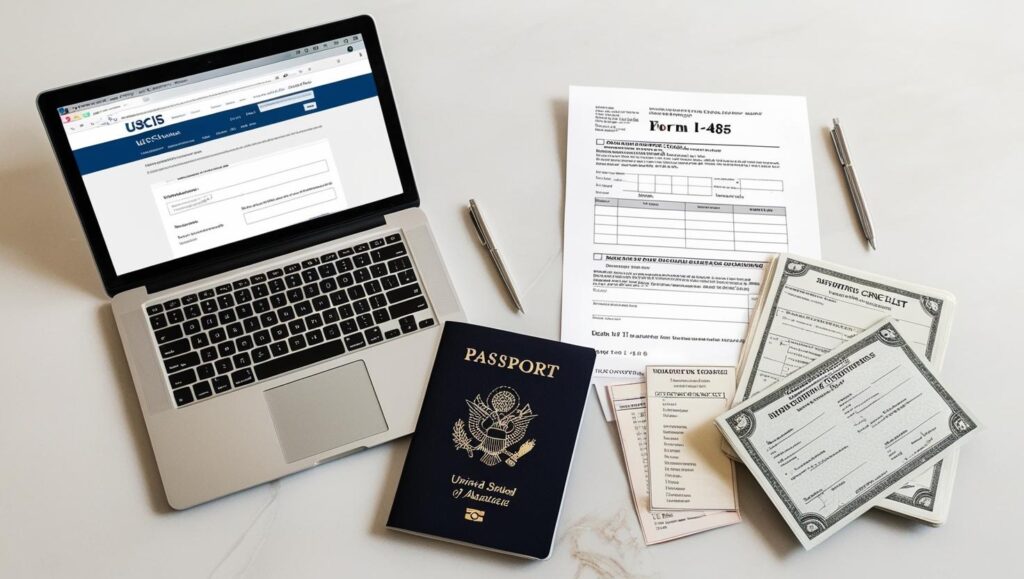Navigating the U.S. immigration process can feel overwhelming, especially when it comes to filing Form I-485, the Application to Register Permanent Residence or Adjust Status. This form is a critical step for individuals already in the United States who want to transition from a temporary visa to becoming a lawful permanent resident (green card holder). In this guide, we’ll break down the purpose of Form I-485, the application process, required supporting documents, and what to expect during the processing time. Whether you’re filing on your own or working with an immigration attorney, this guide will help you understand how to file Form I-485 and successfully navigate the adjustment of status application.
What Is Form I-485?
Form I-485, officially known as the Application to Register Permanent Residence or Adjust Status, is used by individuals in the U.S. to apply for a green card without having to return to their home country for consular processing. This process, called adjustment of status, allows eligible applicants to change their immigration status to that of a lawful permanent resident while remaining in the United States.
The purpose of Form I-485 is to provide the U.S. Citizenship and Immigration Services (USCIS) with the necessary information to determine your eligibility for a green card. It’s often filed in conjunction with other forms, such as Form I-130 (Petition for Alien Relative) or Form I-140 (Immigrant Petition for Alien Worker), depending on your immigration category.

Who Is Eligible to File Form I-485?
Not everyone can file Form I-485. To be eligible, you must meet specific criteria, including:
- Having an immigrant visa immediately available (check the Visa Bulletin for availability).
- Being physically present in the United States.
- Having entered the U.S. lawfully (e.g., with a valid visa or parole).
- Meeting the requirements of your specific green card category (e.g., family-based, employment-based, asylum, or refugee status).
If you’re unsure about your eligibility, consulting an immigration attorney can help clarify your situation.
How to File Form I-485: Step-by-Step Application Process
Filing the I-485 application involves several steps. Here’s a breakdown of the application process:
1. Gather Supporting Documents
To ensure your application is complete, you’ll need to submit various supporting documents, including:
- A copy of your passport and visa.
- Proof of lawful entry (e.g., Form I-94 Arrival/Departure Record).
- Birth certificate or other proof of identity.
- Marriage certificate (if applying as a spouse).
- Evidence of financial support (Form I-864, Affidavit of Support, if required).
- Medical examination report (Form I-693).
Make sure to review the Form I-485 instructions carefully to avoid missing any required documents.
2. Complete Form I-485
When filling out Form I-485, accuracy is crucial. Double-check all information, including your personal details, immigration history, and eligibility category. Mistakes or omissions can lead to delays or even denials.
3. Pay the Filing Fee
The filing fee for Form I-485 varies depending on your age and immigration category. Use the USCIS fee calculator to determine the exact amount. You can pay by check, money order, or credit card using Form G-1450.
4. Submit Your Application
Once you’ve completed the form and gathered all required documents, you’ll need to mail your application to the appropriate USCIS field office or direct filing address. Be sure to include the correct filing instructions to avoid processing delays.

What Happens After You File Form I-485?
After you file the I-485 application, here’s what you can expect:
1. Receipt Notice
USCIS will send you a receipt notice (Form I-797) confirming that your application has been received. This notice will include your receipt number, which you can use to track the status of your I-485 application online.
2. Biometrics Appointment
You’ll receive a notice for a biometrics appointment, where USCIS will collect your fingerprints, photo, and signature. This step is required for background checks.
3. Employment Authorization and Advance Parole
If you also filed Form I-765 (Application for Employment Authorization) and Form I-131 (Application for Travel Document) with your I-485, you may receive an Employment Authorization Document (EAD) and advance parole card. These allow you to work and travel while your application is pending.
4. Interview
In most cases, USCIS will schedule an interview to review your application and verify your eligibility. Be prepared to answer questions about your immigration history, supporting documents, and relationship to the petitioner (if applicable).
5. Decision
After the interview, USCIS will either approve your application, request additional evidence, or deny your case. If approved, you’ll receive your green card in the mail.
How Long Does the I-485 Processing Time Take?
The processing time for Form I-485 varies depending on your immigration category, USCIS workload, and the USCIS field office handling your case. On average, it can take anywhere from 8 months to over 2 years. Checking the processing times for Form I-485 on the USCIS website can give you a better idea of what to expect.

Common I-485 FAQs
Here are answers to some frequently asked questions about the I-485 adjustment of status process:
Can I file Form I-485 and Form I-130 together?
Yes, if you’re applying for a family-based green card, you can file Form I-485 and Form I-130 (Petition for Alien Relative) at the same time. This is known as concurrent filing.
What happens if my visa is no longer available?
If your visa category retrogresses (becomes unavailable), USCIS will pause your application until a visa becomes available again.
Can I work while my I-485 is pending?
Yes, if you file Form I-765 and receive an Employment Authorization Document (EAD), you can work legally in the U.S. while waiting for your green card.
What is the purpose of Form I-485?
The purpose of Form I-485, also known as the Application to Register Permanent Residence or Adjust Status, is to apply for a green card if you’re already in the United States. This form is used to adjust your status from a temporary visa holder to a permanent resident. It’s a crucial step in the process of getting a green card and becoming a lawful permanent resident of the United States.
Who is eligible to file Form I-485 for adjustment of status?
You may file Form I-485 if you’re eligible for a green card and meet certain criteria. This typically includes individuals who have an approved immigrant petition (like Form I-130 or Form I-140), those with immediate relative status, or those who qualify under special programs. It’s important to note that you must be physically present in the U.S. and have a visa available in your category before you can file the I-485 application.
What documents must I submit with my I-485 adjustment of status application?
When you file the I-485, you must submit several supporting documents. These typically include a copy of your birth certificate, passport-style photos, a copy of your government-issued ID, medical examination results (Form I-693), and evidence of your eligibility for adjustment. Depending on your specific case, you may also need to submit Form I-94, employment authorization documents, or other relevant forms. Always refer to the current Form I-485 instructions for the most up-to-date requirements.
Can I file Form I-485 together with other forms?
Yes, in many cases, you can file Form I-485 together with other related forms. For instance, you might file Form I-485 concurrently with Form I-130 (Petition for Alien Relative) if you’re adjusting based on a family relationship. You can also often file Form I-765 (Application for Employment Authorization) and Form I-131 (Application for Travel Document) along with your I-485. This is sometimes referred to as “concurrent filing” and can streamline the process.
How long does it take to process Form I-485?
The processing time for Form I-485 can vary significantly depending on various factors, including the USCIS workload, your basis for filing, and the completeness of your application. As of 2024, processing times can range from several months to over a year. While premium processing is available for some employment-based categories, it doesn’t apply to Form I-485 itself. You can check current processing times on the USCIS website.
Can I work and travel while my I-485 application is pending?
Yes, you can apply for work authorization and travel permission while your I-485 is pending. By filing Form I-765, you can obtain an Employment Authorization Document (EAD) that allows you to work. Similarly, filing Form I-131 can provide you with an Advance Parole document for travel. Many applicants choose to file these forms together with their I-485 to ensure they can work and travel during the adjustment of status process.
What happens if USCIS denies my Form I-485?
If USCIS denies your Form I-485, you may have options depending on your specific situation. In some cases, you might be able to file a motion to reopen or reconsider, or you may need to leave the country if your underlying status has expired. It’s crucial to consult with an immigration attorney if your I-485 is denied to understand your options and the potential implications for your immigration status.
Final Thoughts on Filing Form I-485
Filing Form I-485 is a significant step toward becoming a permanent resident of the United States. While the process can be complex, understanding the purpose of Form I-485, gathering the right supporting documents, and following the form instructions can help ensure a smooth application. If you’re unsure about any part of the process, consider consulting an immigration attorney to guide you through your adjustment of status application.
By staying informed and organized, you’ll be one step closer to achieving your goal of receiving a green card and becoming a lawful permanent resident. And if you intend to self petition through EB1A or EB2-NIW route, we could help you with all the letter writing requirements.

